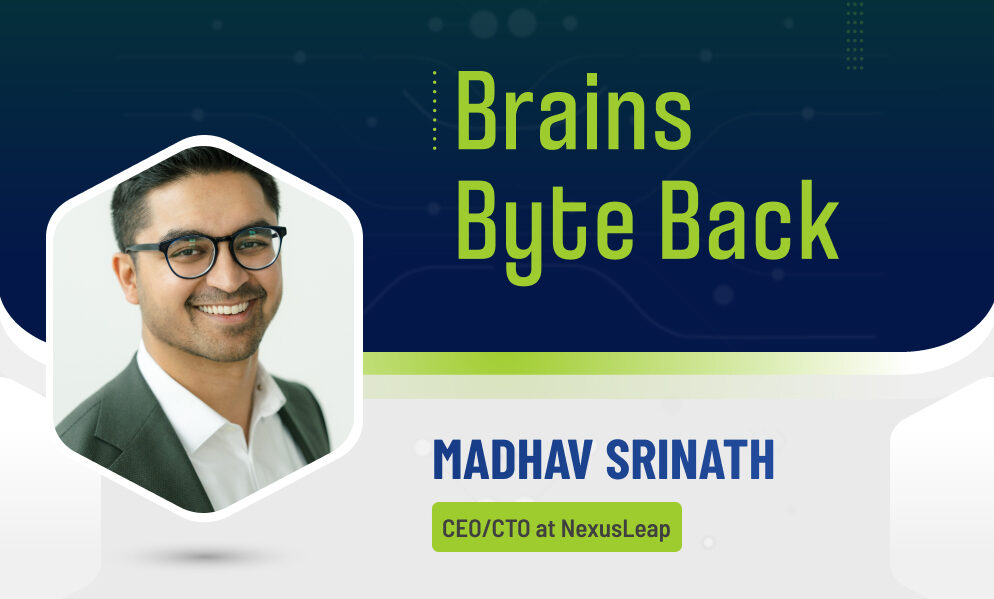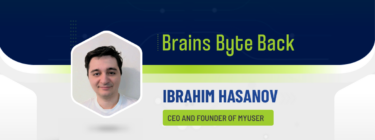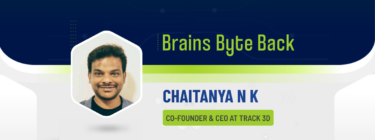In today’s episode of the Brains Byte Back podcast, we speak with Madhav Srinath, CEO and CTO of NexusLeap, a technology and management consulting firm focused on helping organizations make sense of their data and use it to make critical business decisions.
Srinath shares the story of how NexusLeap started during the pandemic, helping food distributors consolidate data and provide insights to solve the problem of food distribution during this difficult time.
Srinath also explains the meaning behind the name NexusLeap, which encapsulates the company’s mission to help businesses break free from what they know and take a leap into using data to drive critical decisions.
For Srinath, “Nexus” refers to the congregation of important decisions and data, while “Leap” refers to the need to jump into the future to keep up with new challenges, problems, and technologies.
Additionally, Srinath shares advice for businesses looking to improve their data management practices. He suggests starting with a data audit in order to identify areas for improvement, create a roadmap for data management, and involve all stakeholders in the process.
We also discuss the future of cloud and data services. During this segment Srinath highlights the importance of cloud computing, stressing that it should be used to build only what is necessary without taking on a lot of overhead or paying more than is required for what is needed.
He predicts that we will see a rising number of cloud platform providers partnering with AI tech providers to create an experience for users that seamlessly integrates cloud and AI technologies.
And finally, Srinath opens up about the 10-year goal he shares with his wife to purchase large plots of land and build infrastructure to rescue as many animals as they can, alongside a desire to facilitate better human-animal connections using technology.
You can listen to the episode below, or on Spotify, Anchor, Apple Podcasts, Breaker, Google Podcasts, Stitcher, Overcast, Listen Notes, PodBean, and Radio Public.
Alternatively, you can find a transcript below:
Madhav: My name is Madhav Srinath, it is really nice to meet you all. NexusLeap is a consulting company focused on helping organizations large or small, make sense of their data, bring it in a secure repository, and help them use that data to make decisions that are critical for their business and basically, for their clients right to drive business impact through data. That’s, that’s our model here.
Sam: Awesome, fantastic. Well, data is something that’s come up a lot in the show, and there’s no doubt that it’s going to continue to play a huge role in our lives. So I’m really excited to have this conversation with you. And before we get any further, I really want to know like, When and how did NexusLeap? First start?
Madhav: Yeah, so NexusLeap started in the middle of the, I guess, starting of the pandemic, we started in a row, kind of responding to some of the biggest concerns out there in the very beginning of the pandemic around food distribution, because the model changed really where people were staying at home or not really going to restaurants. And so food distributors had just a different way of having to distribute food in general. And one of the biggest ones out there reached out to me, and we started working on ways to consolidate data, and provide the right insights to their internal stakeholders so that they can better solve this problem of food distribution with the pandemic, kind of changing things around. So it was really interesting, Sam, from there, we’ve grown from, you know, delivering value to these large enterprises, like distributors that have so many different stakeholders to distilling our core values and our really our value proposition itself to be around helping businesses use their data to drive critical decisions.
Sam: Awesome, fantastic. Well, I have to say, anytime I hear a story of something positive coming out of the pandemic is fantastic. Because obviously, it was such a crap time for so many people. So I loved hearing about how that was something that like, something so positive that came out, I’m glad to hear that. And I have to say, I’m really curious, like, what’s the story behind the name NexusLeap, because to me, it sounds like some sort of like sci-fi film.
Madhav: That’s not a bad place to start. It’s actually interesting. Sam, when we kind of were workshopping for names, it took forever, by the way, we landed on ecstasy, with a variety of logical constraints, like domain availability, right. But also, we wanted to make sure that it was it was something that energise people to break free of what they know, and, and kind of take that leap into something they don’t quite know, but it’s what’s best for them. So if we think about the energy, that’s that’s kind of part of that word, the leap. That was part of what was very important to me. And the next is part of it, it’s just, you know, we want to move from one congregation of important decisions and data. And basically, the state of things as it is, I kind of think of that as a Nexus. And sometimes we have to make the leap so that we can continue to scale, right, we can continue to grow with the new things around us a new challenges, we face the new problems we’re now trying to solve. And I think I just wanted the name to be something that gave everybody our people that work in ecstasy, but also clients that we that we serve, a kind of a way to say, let’s keep moving, let’s keep moving forward and taking those leaps to build something that allows it to scale as best as it can.
Sam: Yeah, I think the use of LEAP, there’s really strong because for me, it does paint a picture of visualization of like stepping in or jumping into the future. Yeah. So that really shines through to me. And I’d also want to know, like, can you give us some insights into what you think the future of cloud and data services hold, and maybe share some emerging trends and disruptive technologies to watch out for?
Madhav: So what’s been really interesting, we’ve seen, it’s a lot has changed over the last few months. You know, we’ve seen something as groundbreaking as ChatGPT become commonplace, which is something that hasn’t really happened in AI in the past. And artificial intelligence in general is just another facet of technology, right? It’s under the umbrella of technology and the improvements and innovation in technology. And if we think about cloud computing, really, it’s the ability for us to kind of build just what we need and pay for exactly that without having to take on a lot of overhead, right? We don’t have to take on servers. We don’t have to build data centers or provision them and put in you know, long term commitments for that. We’re able to just take what’s out there, just that little bit of it and experiment on it and then grow only if it’s necessary. So if we think about cloud computing, I always like to think about the other advancements in technology like AI that’s out there as well, we’ll build on the AI side of things. But from a cloud computing standpoint, I think we’re going to see more and more as these cloud providers are actually going to start implementing, or at least having additional services within their own platforms that allow easy integration of these cloud technologies, with the AI technologies that are getting better and better, as well. So we’re going to see more and more of cloud platform providers partnering with AI tech providers to create this experience for users of either or both of those kinds of technologies to build products that really drive huge impact on their customers.
Sam: Yeah, that’d be really cool to see what comes from that. And it’s so funny that you mentioned ChatGPT, because I swear, in the past six months or so that topic, or the updates come up and every episode, almost, maybe I’m over exaggerating a bit, but it certainly feels that way. So it’s, it’s really cool. And I also understand that you do a lot of analytics work in the cloud, how do you differentiate your approach when working with large enterprises versus startups?
Madhav: Absolutely. That’s a good question, Sam. Well, one thing we find with large enterprises, it’s, it’s a factor of time and adoption of technology. When they started the company, that’s usually what ends up coming into play here. large enterprises, usually, you know, they did, they didn’t become large overnight, they became large over a long period of time. And so they have investments that they’ve made when they first started their businesses as they’ve grown their businesses. And these technological investments they’ve made have led them to kind of take on some legacy software, that they’re continually working on integrating with other software, some of which may also be legacy, but a lot of which are, are new, and kind of upcoming. And so when we work with large enterprises, a lot of the work involves integrating these many different components together. And having a longer term view there’s, there’s a strategy in place that we go in and kind of work with these enterprise leaders to put in place, and the work we end up doing is so much more around intelligence to every facet of the business, right? So we have a strategy in place, but how can we help every facet of this large enterprise? How can we help sales? But can we help marketing? How can we help category management, if that applies to that company? How can we help finance and now each of these components of the business have different ways to use data to do what they need to do for that function. And larger enterprises just tend to have more facets that are that have separate decisions that need to be made, but also still need to look at the same data
Sam: It’s clear that you do very take a very analytical approach to this. And I know that you’ve also already spoken a little bit about like, the advancements of AI. And with AI competition heating up so much, what advice do you have for companies wanting to utilize AI as part of their product or process? And how does that change when considering startups versus enterprises?
Madhav: Definitely, Sam. So we talked about large enterprises having all these different functions, and all these, each of these functions driving impact in different ways, ideally, with similar datasets, but maybe different parts of similar datasets, small companies, what ends up happening is, so many people wear different hats, and the dataset is growing with the company. And they also start off being a lot more. They start off with the best technologies, right? They start off with the latest CRM out there, they start off using the latest cloud platforms. So it becomes less of a question of migrating legacy software, and more of a question of what different what patchwork of technology makes sense right now to put together so that we can solve the problems with, you know, the best effectiveness and speed as possible. Now, if we, you know, with that differentiation in place, small companies when they try to adopt something like artificial intelligence, this depends a lot on the company itself and the problem they’re trying to solve. But I always recommend that we never make AI a core component of their product unless they’re willing to bet everything on that. Usually what ends up happening is it’s a technology product that is very useful. It’s easy to use for their customers. It has a lot of different features. And maybe AI can be one of those many features, that ends up being very useful to companies. And from an implementation perspective. You always want to think about the way the competitive landscape that you’re in as your company and your competitors and the competitive landscape. AI companies are in with their AI competitors. And if you want to make the most of it, you kind of want to make sure that AI companies can innovate on, their proprietary algorithms, and you have what you need to integrate with the latest and greatest they come out with. And usually what ends up happening, Sam is that that differentiating factor that you end up having is the data set that you carefully curate, from when you start your product and start accumulating data to when you realize that using AI is a good part of this, you know, it’s a good next step here. And therefore you have you have this differentiating factor, and you have the latest tech, when you combine these two in a very modular fashion, you’re never really having to make AI core component of what you do, you can always just take advantage of the latest and greatest out there knowing that your differentiating factors, the data that you’ve compiled and curated.
Sam: Fantastic, well, it sounds like you have like so much knowledge to share in this space. And I’m sure we could go on and on about this. But I really do want to take a step away from like, next sleep. And for my final question asked you on a completely separate note, something that struck me about you, which I find so interesting, because I love animals. And I know you do too, as I saw on your LinkedIn that you said, my wife and I share a 10 year goal to be of finance, to be in a financial position to purchase large plots of land and built infrastructure to rescue as many animals as possible. In addition, we want to facilitate better human animal connections using technology. But to be quite honest, outside of ideas like Uber for dog training, we have no idea what that might look like yet. This is so fantastic. And I love taking a step back and speaking with people personally, to understand how they operate outside of their role as well. And this is a fantastic example this, like when was this plan established? And do you have any updates on how it’s going?
Madhav: I’m so glad you looked into that side of things, Sam. I think one thing that’s no secret is my wife and I absolutely love animals. If we could, we’d have far more than we do. Now. Currently, we have two wonderful dogs, named Simba and Nala, we love Lion King as well. So you know, different motivations and inspirations that plan we’ve had, it’s one of those things where we have never been in a situation where we’re we’re kind of going after dollars for the sake of getting more dollars. And that’s interesting, because it’s maybe something a lot of people want to say. And it’s a lot of a lot of people with a philanthropic mindset also would say that. The reason that we say that is really because that’s how we find ourselves being happy, is really taking care of our dogs, our family in that way. They’re very much our family at this point. And they always will be. And if we think about this goal, if we’re like, Listen, you know, we want to build this business. And by the way, my wife and I work together and next to sleep. That’s one of the main reasons where we’re so into this, as a family, we’re all into this company, and this, this conviction of being able to build better surrounding infrastructure and tools for data decision making. We’re both in this together. And we have a shared goal of maybe getting into ventures that are not, you know, profitable per se, we’re not going after it to make a profitable venture. We’re just going after it because it’s something that is really going to add impact in a different way that we really resonate with. So for us, if we think about, you know, we have two dogs, what if we had 200? I mean, couldn’t fit in our house, right? It couldn’t fit in? I don’t know, probably not, maybe one day, but really, what ends up happening is, it’s really not about us, it’s not about us and our 200 dogs, it’s about the impact we can have with animals at large, you know, and I think that’s where we as human beings can put ourselves in positions where we, we get this abstract thing called money, and we can use that to then buy other things that we want. And then we just kind of go on the cycle. And, you know, animals can do that they can, you know, create money for themselves. But we have so much love and respect for animals and we want to put we want to be in a position to kind of advocate for them, maybe not in a animal rights perspective, but just in a way where we can create a, a nice environment for them to be in and kind of help not only animals have a nice environment they’re in where they’re sheltered, they’re fed, they’re taken care of. But the part that I find really interesting is, even if we do all that that’s still very much dependent on us. The part that I think will really make this something that will help everybody is if we foster that human animal connection, Sam, and that’s where things like, you know, a bad dog can become a great dog if it has the right training. You know, and just with that, with that mentality in mind, how can we do things where human beings that maybe don’t know how to train dogs, but, and don’t know how to deal with that dogs or how to raise dogs or they’re in a position where, you know, they’re not doing so well, they don’t have the support to make things happen and, and even, you know, lead in life that they want to lead, we want to find some kind of way of being like, well, let’s foster connection between dogs and, and people, right and I say dogs because it’s the closest animal to us, but just in general animals and people and put it in a way where, you know, we can actually help other people help dogs, and therefore the kind of the livelihood of animals isn’t just us, right? It’s not just us being in a financial position to do it, but rather kind of just make that more exponential give that ability to other people, and therefore, you know, help even more animals. And at some point in time, I think we find ourselves saying this is going to be something we’re really proud of, it would be that it’s kind of creating that
Sam: I completely understand where you’re coming from. I mean, I love animals, myself, I have a cat, and I’ve grown up with cats, dogs, birds, rats, all sorts. And I love animals as well. So I think that’s such a fantastic mission that you’re on. And if people do want to keep up with the work you folks are doing next to sleep, or potentially the work you and your wife are doing to obviously improve and foster a stronger connection between humans and animals, where are the best places they can keep up with you?
Madhav: The one thing I’m on mostly is LinkedIn at this point in time, email is actually a great way as well, I look at every email that comes my way. But I’ll give you both but LinkedIn is where, you know, we’re really, we’re trying to say we’re trying to provide a lot of value to people, outside of an engagement with NexusLeap, we just, we just want to have, I just want to have a way to kind of express to people how they can kind of take this low hanging fruit and put themselves in a better position to take advantage of the technology just exponentially innovating around us. And I think if we on LinkedIn, I’ll give you the link, Sam, but that’s the best way to follow and connect with me. I read all my messages, always very open to a quick phone call and introduction with anybody. And that’s probably the best way LinkedIn is the best way and then email as well.
Sam: Fantastic. Well, we’ll have a link to your LinkedIn in the show notes. But otherwise, I just want to say thank you so much for joining me today. And yeah, all the best work on both of your missions really at NexusLeap and also outside of NexusLeap.
Disclosure: This episode includes a client of an Espacio portfolio company












